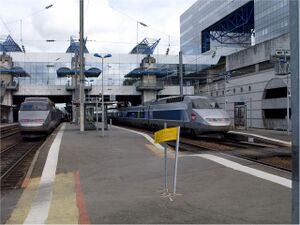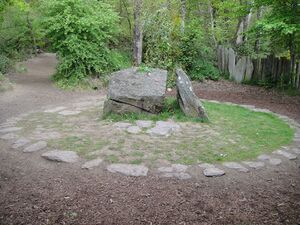Rennes
| Rennes | |||||
|---|---|---|---|---|---|
| Japanese Name | レンヌ | ||||
| Weapon | |||||
| Race | Elf | ||||
| Nationality | |||||
| Birthday | August 4 | ||||
| Constellation | Leo | ||||
| Talents | Hide-n-seek, Making galettes | ||||
| Likes | Galette, Crêpe | ||||
| Dislikes | Places with a lot of people, People that can't maintain a good distance | ||||
| Strengths | Very unafraid of commonly 'scary' things | ||||
| Weaknesses | Not a fan of public speaking | ||||
| Hobbies | Making galettes | ||||
Good day, Monsieur Conductor. My name is Rennes. Before I joined the SSS, I was a Forestier in the Brocéliande Forest. My family has been Forestiers for generations. Leave the hide-and-seek games in the forest to me. Dohyuh... Dohuhhuhhuh... Would you like a galette?
Layers
| Icon | Title | Release Date | Where to Obtain |
|---|---|---|---|
| [Keeper of the Lost Woods] Rennes | 2021 December 22 (EN) | [Relaxing Rebirth in Paradise] Limited Gacha | |
| [Galette's Witch] Rennes | 2022 April 15 (EN) | [Forest Rangers' Eclair] Pick Up Gacha, Premium Gacha | |
| [Want a Tasty Galette‽] Rennes | 2022 May 31 | [Administrative Society Messiah] Pick Up Gacha, Premium Gacha |
Owned Skills
Trivia
- Rennes' birthday is the date of the liberation of Rennes in 1944, ending four years of capture of the city by the Nazi Germans as part of the liberation of Brittany.
- Rennes' elder sister is Brittany and is one of the watchers of Brocéliande Forest, however they are not blood-related.
- Renne's witch and spider design is themed after Morgan Le Fey and the Paimpont Forest. Paimpont Forest is also known as the Brocéliande Forest, where it is the location of Merlin's tomb in Arthurian legends.
- The region of Rennes is famous for galette-saucisse and Ar Pillig crêpe, though Rennes usually makes galette de pomme (apple galette). Galette ("flat cake") is a term used in French cuisine to designate various types of single crust, free-form pie with usually a fruit filling and the crust folded partway over the top of the filling. A crêpe or crepe is a very thin type of pancake. Crêpes originated in Brittany, a region in western France, during the 13th century, and are now consumed around the world.
- Renne's spear design references the station clock housed on the entrance of Gare de Rennes.
- The buildings in the background of [Want a Tasty Galette?] is part of the Place du Champ-Jacquet, one of Rennes' many historical center streets.
Counterpart
Rennes station (Gare de Rennes) is situated in the town centre of Rennes, France. It is situated on the Paris–Brest, Rennes–Saint-Malo and the Rennes–Redon railways. The station at Rennes was opened in 1857, and was situated a significant walking distance from the city centre. However, since that date the town has expanded and now the station lies in the central part of the city.
It has access to Paris on the TGV, a two-hour trip; and serves Brittany with regular trains to Brest, Lannion, Nantes, Quimper and Saint-Malo. Train service is also available to other cities in France such as Lyon, Montpellier, Marseille, Lille, Aix-en-Provence and Strasbourg. It is also served by Gares station on the VAL Rennes Metro.
The second Rennes station was designed by the architect Thierry Le Berre, on the occasion of the arrival of the TGV Atlantique in 1992. More spacious, it takes the form of a slab overlooking the tracks and allowing a connection with the district from the south of the station. The workshops on Pierre-Martin are maintained.
In order to cope with the increase in traffic (it is expected to double between 2019 and 2025), a third station is being built on the foundations of the previous one. It brings together an enlarged multimodal hub, including the correspondence of the two metro lines, enlarged car parks and 130000 square meters of additional offices, called the "EuroRennes project". The signature of the new station is its roof, made of inflated translucent ethylene tetrafluoroethylene (ETFE), symbolizing a cloud on the ground. The floor of the departure hall is made of bamboo. Wikipedia
Paimpont Forest (Forêt de Paimpont) also known as Brocéliande Forest (Forêt de Brocéliande) is a temperate forest located around the village of Paimpont in the department of Ille-et-Vilaine in Brittany, France. Covering an area of 9,000 hectares, it includes the castles Château de Comper and Château de Trécesson as well as the national historical site the Forges of Paimpont, and is part of a larger forest area that covers the neighboring departments of Morbihan and Côtes-d'Armor. It has been associated with the forest of Brocéliande and many locations from the Arthurian legend, including Val sans retour, the tomb of Merlin, and the fountain of Barenton.
The Paimpont forest benefits from its association, since the 13th century, with the legendary forest of Brocéliande that has become the site of many episodes of the Arthurian legend in the French tradition. The identification with Brocéliande became institutionalized with the creation of the communauté de communes de Brocéliande, which was itself regrouped within a supra-intercommunal structure named the Pays de Brocéliande. The area has been a tourist destination site since the 19th century, especially after 1945. Since 1951, followers of Neo-Druidism also meet there periodically, including in organized ceremonies. The Paimpont sites are implemented through signs and pedestrian trails designed to introduce visitors to Arthurian locations, with explanatory panels linking each place to a legendary tale.
Brocéliande, earlier known as Brocéliande and Brécilien, is a legendary enchanted forest that had a reputation in the medieval European imagination as a place of magic and mystery. Brocéliande is featured in several medieval texts, mostly related to the Arthurian legend and the characters of Merlin, Morgan le Fay, the Lady of the Lake, and some of the Knights of the Round Table. It first appeared in literature in the Roman de Rou chronicle by Wace in 1160 and today is most commonly identified as Paimpont forest in Brittany, France. Wikipedia
Map
Gallery
- Pages using Tabber parser tag
- Pages using DynamicPageList3 parser tag
- Weapon Spear
- Elf
- Verforet
- Leo
- Element Pierce
- Element Wind
- Element Light
- Element Dark
- Train Knights
- France














